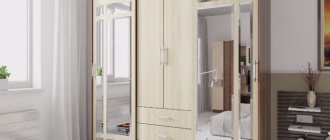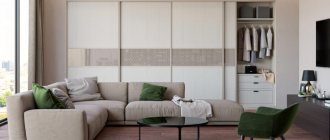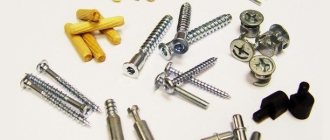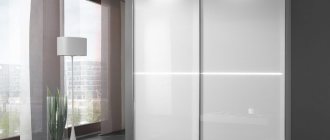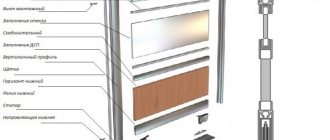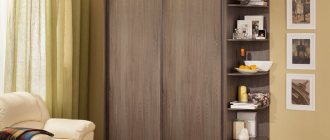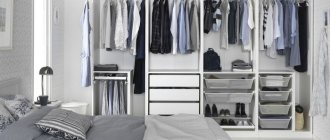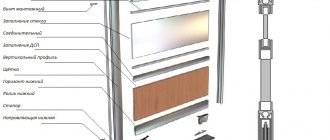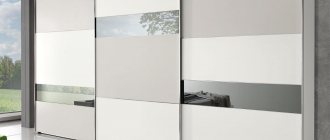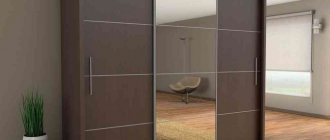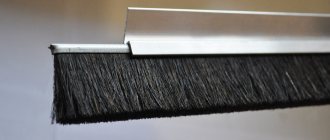Storage organization is always individual: the number of people in the house, their age, tastes, and lifestyle characteristics create completely different needs. In this article we talk in detail about popular options for filling a wardrobe - a universal and spacious storage system. We also analyze ideas for different rooms.
We talked about the stages of planning a storage system in a video
Storage system zoning
Regardless of the configuration, any product inside is divided into conventional horizontal zones. As a rule, there are three of them.
- The lower zone is a compartment located below eye level and arm's length. Usually reserved for placing shoes, bed linen (in the bedroom or nursery), suitcases, bags or sports equipment. Here you can store any heavy items whose weight cannot be supported by the upper tier. Placing standard shelves for things in this area is not very convenient, because you will have to constantly bend over to get them, so drawers and pull-out baskets are suitable for filling.
- The middle one is the main part of any closet. This includes everything that is at eye level and that is easy to reach. Therefore, in the middle part there are hangers, shelves and hanging organizers for clothes and linen, which are used constantly. They should always be easy to access and this area should be well lit.
- Upper - the remaining space at the top is allocated for mezzanine shelves, which may not be as easy to reach as things in the middle zone. Most often, this part is used to place seasonal clothing, spare sets of underwear, hats and everything that is rarely worn and, therefore, taken out.
Instagram @design_studio13
Instagram @bodes_studio
Unsplash
Instagram @jo.marie_b
- Storage systems
How to properly plan a closet from IKEA and more: 6 steps
Functional elements
Since the wardrobe is a permanent structure and is intended for long-term use over many years, it is important to carefully consider the composition of its equipment. The modern market offers a wide range of high-quality retractable and stationary functional elements to suit any need.
Due to the low cost, basic configurations are usually equipped to a minimum - only stationary shelves, drawers on roller guides and longitudinal rods for hangers will be installed in the furniture. This set satisfies the needs of most owners, but does not allow the full potential of the design to be revealed. Therefore, in order for the filling of the wardrobe to bring maximum benefit, you must be prepared for additional costs for the installation of auxiliary functional elements.
Among the most popular standard devices are:
- Pantograph (furniture elevator). A mechanism that allows you to lower the horizontal bar to the required level.
- Mesh baskets (pull-out, stationary). Metal wire baskets for storing clothes and shoes.
- Linen baskets (with fabric bag). Designed for storing used and dirty linen.
- Transverse (end) hangers. Typically used in narrow structures when using a classic rod is impractical.
- Spiral hangers. Screw design for more organized storage.
- Carousels for hangers. Rotating mechanism for attaching hangers.
- Trouser holders. A retractable or stationary mechanism with several small rods/hangers for storing trousers.
- Drawers with cells. Drawers with dividers for storing accessories, jewelry, organizers or underwear.
- Cascading shoe racks. A system of several inclined shelves with mesh or anti-slip coating.
- Built-in ironing board. Folding one-piece or retractable folding ironing board.
Also, depending on personal preferences or wishes, highly specialized holders/baskets can be made to order for storing household appliances, televisions, collections of accessories, toys, hobby items and any other things.
Filling a wardrobe with dimensions - examples
All images are clickable.
Width ≤2 meters
Width ≤3 meters
Corner
Built-in
By number of doors
Contact the Promir furniture factory for the manufacture of sliding wardrobes in individual sizes - we guarantee high quality and optimal prices.
Design examples
Processed with VSCO with hb1 presetNote! How to crochet a chair pad?
Let's discuss this article together:
Click to cancel reply.
Layout Tips
Photos of various layouts of the interior space of cabinets can be seen below. Each owner of this piece of furniture independently decides what arrangement of objects will be used. To get a truly beautiful and convenient design that will be comfortable to use, take into account the advice of experts:
- A free space is left on the left where outer or formal clothing is kept on hangers;
- on the right are shelves on which various things and clothes are placed;
- on top there is bed linen, large bags, a blanket or other similar items that are not used by people too often, so they rarely need to be taken out of the closet;
- At the bottom there is a place for shoes, for which narrow cabinets are used, often equipped with a special plastic mesh.
This layout is considered the most popular and frequently used. Each owner of a living space independently determines what layout will be used for the cabinet, and this takes into account the selected design, the number of people using the product, as well as user preferences.
SHOES
There are two options: either in original boxes, with photographs pasted on them (what a pity that Polaroids are out of circulation).
Or buy boxes with transparent windows from IKEA.
Because the principle works with shoes like nothing else: if it is not visible, then it is not there.
And rummaging through all the boxes in search of the right pair is not a pleasant task. For a long life of your favorite shoes, learn the rule: if you decide to put them in a box, clean them first. And stuff it with paper to avoid deformation.
HOW TO HANG SCARFS?
The main task is still the same: they must be visible, so boxes and crates are not suitable for this purpose; a moth will get to the scarf lying at the bottom of the box much faster than you. So, either in a stack on a shelf, or, if there are not many of them, hang them on special structures, of which there are many on sale.
Recommendations
Some general filling recommendations:
- Each door should have its own cabinet compartment, otherwise it will be inconvenient to reach some shelves;
- areas with rods should be made wider than areas with shelves;
- drawers should not fall on door frames or hinges;
- if the retractable element has a handle, its length is taken into account during the design;
- It is not recommended to attach the rods to the walls of the cabinet - they should be fenced off with shelves or drawers;
- the mezzanine should be placed behind a common door and divided according to the compartments;
- shelves 80 cm wide are placed on the partition, otherwise it will not withstand the load of objects, it will sag and fall;
- rods 1.2 m long must have additional support.
The filling of the cabinet is selected according to your preferences. Recommendations for the placement of elements depend on the size and purpose of the cabinet. When drawing up a project, you should pay attention to functionality and ergonomics.
VISIBLE SPOT
The saying “out of sight, out of mind” also affects memory when it comes to wardrobe. If you don't see a thing, then, as a rule, you don't remember it. And the result is the same sets of things that are constantly in sight. Boring. All you have to do is arrange things so that they can be seen. This, in my opinion, is the main purpose of organizing your wardrobe.
A clothing dump can bring another unpleasant surprise: suppose you suddenly remember a beautiful cardigan that hasn’t been worn for a hundred years. And we decided to take him for a walk. And when they took it out of the deposits, they discovered that it was all crumpled and there were no buttons. It’s good if you have time to put it in order and a button, but what if not? In this case, the item is very often sent back to the pile, where it will lie until it is thrown away or given away. And you could wear it with pleasure.
Do you think this is a rather bleak picture?
So, let's begin to restore world harmony within the framework of a single wardrobe. First you need to determine in what position each item will be stored. Will it hang on a hanger, put it on a shelf, or be stored in a box? The storage method depends, first of all, on the purpose of the item, the type of material and frequency of use.
Planning the internals. Technical points
There are no standards for load selection and production. Wardrobes with sliding doors can be located in the bedroom, hallway, loggia, or nursery. The layout of the cabinet depends on where the product will be located and what will be placed inside.
First of all, the choice of design is influenced by the following factors:
- wall dimensions;
- what the furniture will be used for;
- number of things;
- financial capabilities of the customer.
To develop the internal zone, you need to decide on the number and type of things. For example, if the wardrobe will be located in the corridor, then you need to provide an area for storing outerwear and take into account that such wardrobe items can be long. A place should be provided to store caps, hats, scarves, bags, and umbrellas. There will be no such compartments in the bedroom.
Planning the space inside the closet involves not only the number and method of arrangement of shelves, but also the design of drawers, doors, and mirrors. They can either be built inside the furniture or rearranged, sometimes making redevelopment.
It is important that the supporting parts, fastenings, and crossbars are made of reliable materials that not only withstand the weight of the wardrobe, but also will not damage the clothes. Drawer slides should slide out and lock easily to prevent them from falling out. In this case, the drawers should close softly. The optimal solution is closers that ensure closing without stress on the part of the owners.
To determine the size and number of doors and the breakdown into sections, it should be taken into account that the size of the door is equal to the width of the profile multiplied by 2. Therefore, the width of the built-in drawers should be narrower than the doors. As for the depth of the furniture, to install a pantograph or hanger holders, a width of at least 60 cm is required, and if a retractable hanger system is used, then 45 cm is sufficient.
What is better: install or embed?
A built-in wardrobe in its simplest form is usually a sliding door that spans an alcove or similar portion of the room, thus creating a small walk-in closet.
The idea of a wardrobe in a narrow hallway without a back wall can be very interesting and attractive: it saves money, and the back and side walls return scarce space. This is really worth thinking about if you don't plan on moving anytime soon.
It is unlikely that the parameters of your new home will allow you to use built-in wardrobe elements from your old apartment. In addition, a wardrobe consisting only of a frame and a door will noticeably lose in strength compared to its full-fledged counterpart.
In addition, if the wall on which the wardrobe shelves are located is not perfectly straight, gaps and cracks will form between the shelves and the wall.
Therefore, it is worth ordering a complete wardrobe, which will include all the necessary elements.
Unlike a classic wardrobe, a sliding wardrobe is a technology with a free internal architecture, without divisions or extra shelves and partitions, with a huge internal volume that allows you to distribute everything you need.
Features of corner structures
Models of compartment furniture products can have very different designs and shapes - there are a lot of ideas. In the limited space of small rooms, a common option for a sliding wardrobe is a corner model. Furniture saves space, but the capacity of the cabinet is reduced - it is difficult to use the internal space in the corner of the cabinet. This place is called the "dead" zone. Options for filling the corner compartment design:
- the central part is filled with clothes hangers, and the side sections with shelves and drawers. Additionally, we select open radius-type shelves (rounded edges) on the sides of the sliding wardrobe;
- The corner model can be divided into two main sections of different widths. The left side of the compartment is equipped with spacious shelves - the result is a deep and roomy compartment. On the right side there is a compartment with a clothes rail and narrow shelves;
- An alternative option is to install two rods on top of each other in the central part of the corner model to store things on hangers. The left and right sections are arranged with drawers and spacious shelves, respectively.
Filling corner models is complicated by the inability to fully use the area in the corner of the wardrobe. Radius corner models with convex/concave facades are even more difficult to fill. The edge of the shelves should follow the outlines of the radial façade panels. This point also affects the capacity of the wardrobe.
Using closets to keep things neat and organized leads to a tidy room. Wardrobe items, accessories, home textiles, and bedding are neatly arranged on the shelves. It is convenient to take things out and put them in place, since in most cases the filling of compartment furniture is carried out taking into account the needs of all family members.
Required departments
In the photographs you can see many cabinets with different parameters. Design, size and other parameters are always taken into account when choosing. Before choosing a specific product, consider how many different items will be stored on the shelves. Only by placing each item in the right area of the wardrobe will you make the perfect order in this design.
The number of different components in cabinets can vary greatly, since the model itself, its dimensions and other properties are taken into account. There will be no equal filling of a corner and rectangular cabinet. The following departments of any model are required:
- The lower middle section is a significant compartment, which, as a rule, houses large household appliances, large blankets or pillows, but most often a vacuum cleaner;
- Underwear drawers up to 30 cm deep, filled with women's or men's underwear, socks and other similar items of clothing;
- Bar area, often equipped with a special wardrobe lift, which makes it easier to place clothes in different places;
- special tripods for trousers or special objects to which ties are attached;
- Drawers about 10 cm high, equipped with special small cells that allow you to conveniently store various small items, accessories and tools;
- Large shelves, the distance between them can vary significantly, as it is chosen after deciding what will be placed on them;
- shoe boxes, usually located at the bottom of the closet, take into account the size of various shoes and even boots used in winter, and should not wrinkle or become deformed during storage;
- Special shelves or hooks for bags with hard, heavy items, preferably located on a shelf, should be hung from hooks, but small, soft bags should be hung from hooks;
- Often the interior design of a wardrobe includes large shelves of various configurations designed to accommodate large suitcases or other travel bags;
- The top of the closet is usually left free for storing bedding.
The number of compartments, the size of the cabinet and other parameters of this furniture depend on the planned content, so it is recommended to plan in advance what will be contained in a two- or three-door cabinet.
OUTERWEAR
The problem with it is that half the time it is worn very actively, and the other half it is not taken out of the closet at all. Therefore, before putting it in the closet (fur - only in a closet or in a fabric case, it will “suffocate” in a plastic bag) - be sure to clean it and put in an anti-moth agent. Don't be afraid, they no longer smell like old mothballs. In general, in order to avoid a colony of these winged friends of humans, often go through clothes that have not been worn for a long time and do not forget to periodically change the tablets.
To be honest, organizing your wardrobe takes a lot of time and effort. But the result is visible immediately, you can use it for a long time, and for the titanic work done, you can treat yourself to, say, a new blouse. After all, you now know for sure that you don’t have exactly this one yet! 
Photo
Sources
- https://prihozha.ru/74-napolnenie-shkafa-kupe-dlya-prihozhey-shemy-chertezhi-i-fotografii.html
- https://fotollia.ru/shkaf/vnutrennee-napolnenie-v-prihozhey
- https://mblx.ru/holl/270-napolnenie-shkafa-kupe-v-prihozhuyu.html
- https://stroyday.ru/stroitelstvo-doma/interernoe-oformlenie-doma/napolnenie-shkafa-kupe-v-prixozhuyu-sovety.html
- https://dekoriko.ru/shkaf-kupe/v-prihozhuyu-dizajn-vnutrennih-variantov-napolnyaemosti/
HANGERS
Now let’s take hold of the hangers and throw out all the wire misunderstandings, slanted planks and plastic monsters 3 sizes too large that have crept into your closet. This trinity can cause irreparable damage to delicate and thin tissues or skin. Wire hangers are needed to bring clothes from the dry cleaner or workshop. All. You cannot store clothes on them! Under its own weight, the fabric stretches, and the thin frame of the hanger is very easily deformed. And, once again taking out your favorite jacket, you may find “ears” on the shoulders or sleeves (if the hanger is the wrong size), similar in shape to the ugly bubbles of sweatpants, only small. I'm not even talking about the exquisitely colored rust stains on a light jacket, for example.
Option two - wooden hangers. Just please, not the creepy two-plank designs that remember your mother’s prom dress. But wide ones with rounded ends are what you need. The only thing is that things can easily slip off from patent-leather hangers, so fasten the buttons. The advantages of such hangers are at the same time their disadvantage: they are solid, beautiful, take up a lot of space in the closet and are expensive. Such a Bentley among hangers. This category, very beautiful and very expensive, includes hangers covered with leather.
If functionality is most important to you, then welcome to the world of plastic hangers. But not powerful cast monsters on which you can hang knight's armor, and nothing will survive. The crossbar next to the closet will probably break. Plastic hangers are very convenient for putting things in order. Lightweight, functional, for delicate thin fabrics there are silicone pads so that silk or cambric does not slip off.
The most ideal, in my experience, are vinyl coated hangers. If anyone is sad about the thinness of wire, this is the place for you. They are almost as thin, but they no longer pull clothes because of their size, a lot of them can fit in a closet, and the special coating, that same vinyl (yes, it turns out that not only records are made from it), does not allow them to slip and become deformed even the thinnest and most delicate fabrics.
A general rule for all hangers: they should be the right size for you! It is necessary. Too large will cause bubbles on the sleeves, and too small will cause bubbles on the shoulders.
It is also recommended that all hangers be the same, so that when you open the closet, you see an orderly row of hanging clothes, and not sleeves and shoulders sticking out at random.
A few words about fabric hangers: they look very cute, ideal for thin blouses, but take up a lot of space. One way out: take out one or two shelves in a closet with shelves, nail a crossbar in the resulting space and hang soft hangers with blouses on it.
A general rule for everyone: hangers should be smooth, with recesses for straps or special loops for skirts or dresses. Some models have a crossbar or tucks for trousers. Whether you use them or not is up to you. Just keep in mind that in this position the trousers may wrinkle.
If ironing is not so scary for you, then you can save space by purchasing these hangers for your trousers.
What is not recommended to be stored on hangers is knitwear, especially thin ones, woolen sweaters, cardigans and other fabrics that can deform under their own weight. It is best to fold them in neat piles, sorted by density.
A little trick: alternate in one pile, say, sweaters or tops, bright and dark. This way they will be more noticeable and will not merge with each other. The same stacks are convenient for storing jeans.
Some people prefer to store knitted items vertically in a chest of drawers or drawers, as the Japanese do. To learn more about this method, read Marie Kondo's book The Magic of Tidying Up. But let me note right away that this method is not suitable for everyone. Didn't suit me. Things get very wrinkled 
And this is a life hack for girls who especially like to plan everything. I learned about it from my basic course student, who approached all tasks very responsibly.
After a total revision of her wardrobe, she photographed ALL her looks, sent them to me, we adjusted them a little, and then she just took and hung her photos on the inside of the closet doors. She no longer faced the question of “what to wear.” 
I think it's brilliant!
DECORATIONS
For jewelry and jewelry, it is most convenient to splurge on a special chest of drawers or dividers with a larger number of sections. The more sections, the better!
Necklaces and chains can be hung on hooks; when lying down, they happily and quickly get mixed up with each other.
And glasses can also be hung on a hanger!
BELTS AND TIES
This is where the delimiter module comes in handy. Their cells can accommodate the entire collection. Roll into a ring, not too tightly, with the buckle facing outward to avoid creases. And each one in a separate cell. Wide ones, if space allows, can be laid out flat, and corset ones can be placed vertically.
Another option is to hang them on special hangers. A belt hanger can be attached to a closet door, provided that the belts do not touch clothing (otherwise, hello, puffs!)
